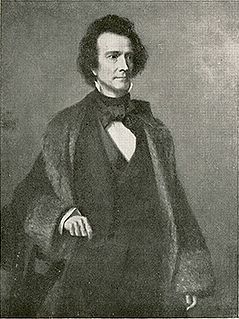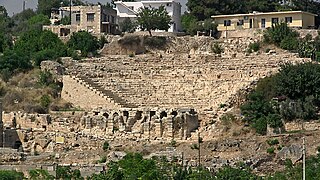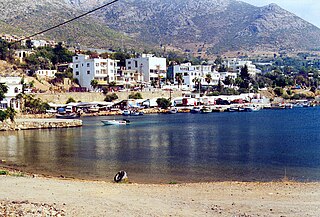Argumentum ad baculum is the fallacy committed when one appeals to force or the threat of force to bring about the acceptance of a conclusion. One participates in argumentum ad baculum when one points out the negative consequences of holding the contrary position. It is a specific case of the negative form of an argument to the consequences.

Events from the first millennium AD in Canada.
The bathtub hoax was a famous hoax perpetrated by the American journalist H. L. Mencken involving the publication of a fictitious history of the bathtub.
The Latin phrase ad interim means "in the meantime" or "temporarily".

Lindholm Høje is a major Viking burial site and former settlement situated to the north of and overlooking the city of Aalborg in Denmark.

Hugh Swinton Legaré was an American lawyer and politician.

James Cochran Dobbin was a nineteenth-century politician and lawyer who served as United States Secretary of the Navy from 1853 to 1857.

The Wielbark culture or East Pomeranian-Mazovian is part of an Iron Age archaeological complex that dates from the 1st century AD to the 4th century AD.
The stone circles of the Iron Age were a characteristic burial custom of southern Scandinavia, especially on Gotland and in Götaland during the Pre-Roman Iron Age and the Roman Iron Age. In Sweden, they are called Domarringar, Domkretsar or Domarsäten. They should not be confused with the Stone circles of the Bronze Age and Britain.

Elaiussa Sebaste or Elaeousa Sebaste was an ancient Roman town located 55 km (34 mi) from Mersin in the direction of Silifke in Cilicia on the southern coast of Anatolia. Elaiussa, meaning olive, was founded in the 2nd century B.C. on a tiny island attached to the mainland by a narrow isthmus in Mediterranean Sea.

The Epistulae Morales ad Lucilium, also known as the Moral Epistles and Letters from a Stoic, is a collection of 124 letters that Seneca the Younger wrote at the end of his life, during his retirement, after he had worked for the Emperor Nero for more than ten years. They are addressed to Lucilius, the then procurator of Sicily, who is known only through Seneca's writings. Regardless of how Seneca and Lucilius actually corresponded, it is clear that Seneca crafted the letters with a broad readership in mind.

Jaina Island is a pre-Columbian Maya archaeological site in the present-day Mexican state of Campeche. A small limestone island on the Yucatán Peninsula's Gulf coast with only a tidal inlet separating it from the mainland, Jaina served as an elite Maya burial site, and is notable for the high number of fine ceramic figurines excavated there.

The Imam Husain Shrine or the Station of Imam Husayn ibn Ali is the mosque and burial site of Husayn ibn Ali, the third Imam of Islam, in the city of Karbala’, Iraq. It stands on the site of the Mausoleum of Imam Husayn, who was a grandson of Muhammad, near the place where he was martyred during the Battle of Karbala’ in 680 C.E. The tomb of Imam Husayn is one of the holiest places for Shi‘ites, outside of Mecca and Medina, and many make pilgrimages to the site. Every year, millions of pilgrims visit the city to observe Ashura, which marks the anniversary of Imam Husayn's death. Every year for Arba'een rituals that occurs forty days after the Day of Ashura up to 45 million people go to the city of Karbala.
The California Democratic Party is the state branch of the United States Democratic Party in the state of California. The party is headquartered in Sacramento, and is led by acting-Chair Alex Gallardo-Rooker.

Aydıncık is a town and district of Mersin Province on the Mediterranean coast of Turkey, 173 km (107 mi) from Mersin and 325 km (202 mi) from Antalya.
Malaysian Jews are Jews living in Malaysia, or those originally from the country. The state of Penang was once home to a Jewish community, until the latter part of the 1970s, by which time most had emigrated due to growing state-sanctioned antisemitism. They were also found elsewhere in the nation, especially in Negeri Sembilan and Malacca. Indications of the growing racial and religious hostility in the nation has caused many Malaysian Jews to leave or flee the country. The Malaysian Jewish community consists of Jews of Sephardic origin who live amongst the Kristang people (Malacca-Portuguese), Mizrahi Jews, Malabar Jews and Ashkenazi Jews.

Boffles is a commune in the Pas-de-Calais department in the Hauts-de-France region in northern France.

Poland in antiquity is characterized by peoples belonging to numerous archeological cultures living in and migrating through various parts of the territory that now constitutes Poland in an era that dates from about 400 BC to 450–500 AD. These people are identified as Slavic, Celtic, Germanic, Baltic, Thracian, Avar, and Scythian tribes. Other groups, difficult to identify, were most likely also present, as ethnic composition of archeological cultures is often poorly recognized. While lacking use of a written language to any appreciable degree, many of them developed relatively advanced material culture and social organization, as evidenced by the archeological record, for example judged by the presence of richly furnished, dynastic "princely" graves. Characteristic of the period was high geographical migration rate of large groups of people, even equivalents of today's nations. This article covers the continuation of the Iron Age (see Bronze and Iron Age Poland), the La Tène and Roman influence and Migration periods. La Tène period is subdivided into La Tène A, 450 to 400 BC; La Tène B, 400 to 250 BC; La Tène C, 250 to 150 BC; La Tène D, 150 to 0 BC. 400 to 200 BC is also considered the early pre-Roman period and 200 to 0 BC the younger pre-Roman period (A). It was followed by the period of Roman influence, of which the early stage had lasted from 0 to 150 AD (0–80 B1, 80–150 B2), and the late stage from 150 to 375 AD (150–250 C1, 250–300 C2, 300–375 C3). 375 to 500 AD constituted the (pre-Slavic) Migration Period (D and E).
Euphrates was an eminent Stoic philosopher, who lived c. 35–118 AD.

The Archaeological Museum of Veroia is one of the most important archaeological museums in Macedonia, Greece. The museum was established in 1965 in a building constructed especially for the purpose in Elia, one of the loveliest parts of the town. Finds from the Palaeolithic to the Ottoman period are displayed in its three halls.
















